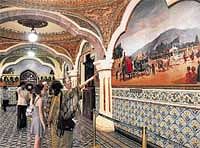

Two years down the line, the famous Amba Vilasa Palace, popularly known as Mysore Palace will celebrate its centenary year. Built in 1912, the grand structure will complete 100 years with its vivid colours, exuberant decoration and grandeur intact.
With The New York Times listing Mysore among the four best destinations in the World, the Palace has attracted record visitors during 2009-10, a whopping 27.71 lakh people, breaking its own record of the year 2006 - 07 when 25.26 lakh people visited the Palace. And, among the most admired sections of Amba Vilasa, the Kalyanamantapa (marriage hall) draws tourists, all thanks to its renewed vibrancy. The famous oil paintings that adorn the east, south and west of the marriage hall, which were impoverished because of time, have been restored to their original glory.
Done by celebrated palace artists
These paintings surrounding the three sides of the quadrangle were executed by some of the celebrated palace artists including K Keshaviah, S N Swamy, Y Nagaraju, Shankararaju, S R Iyengar and Y Subramanya Raju based on actual photographs between the years 1934 and 1945. They immortalise royal grandeur and the famous Dasara festivities.
There are 26 paintings depicting the Dasara procession. Other subjects of the murals include the birthday procession of Krishnaraja Wodeyar IV, the royal family members performing Durga pooja, car festival of Goddess Chamundeshwari atop Chamundi hill and the celebration of Krishna Janmashtami. The mural that stands apart is that of the King with his brother and nephew seated in the Golden Howdah surmounted on the decorated, caparisoned elephant, ready to leave from the Palace premises.
Master artist Keshavaiah has executed the panel with great skill, giving it a three-dimensional effect. But, the murals showing signs of degradation worried the Palace Board officials till 2006 when the then Executive Officer and Deputy Commissioner S Selva Kumar struck upon the idea of restoration. The Regional Conservation Laboratory (RCL), a wing of National Conservation Laboratory of the Union Ministry of Culture was of great help.
Thanks to the technical expertise and scientific restoration process taken up by the RCL team, the 31 murals now have bright colours. The job was not an easy one. It took almost two years for RCL to complete the restoration work. Says B V Kharbade, Head and and Project Officer of RCL, the murals suffered from flaking, cracks, loss of paint, accidental tears, sagging, loosening of canvas, folding besides other problems.
“As per the memorandum of understanding (MoU) with the Palace Board, we decided to take up the restoration of these paintings one by one for conservation treatment. The size of murals, 12 ft x 16 ft posed a challenge when it came to dislodging and transporting them. A wooden trolley was specially designed for the purpose. Close observation of murals revealed complex problems,” he told Spectrum.
Challenges of restoration
Some of the paintings had splashes of cement, mortar, lime wash, carpenter polish and very thick layer of dust and dirt because of poor maintenance and ignorance while carrying paint works in the Palace. It was a major challenge as it needed different treatment. Then, we prepared a conservation strategy after carrying out a detailed documentation with conventional method, digital photography and graphic documentation methods and recording the problems with each murals.
Special chemicals were used to remove the stains of cement, lime wash and polish, he reveals. In addition to applying regular principles of conservation work, we provided a new touch to the paintings with reversible colours and reintegration.
The Conservation Laboratory also provided a relining to the weak canvas of murals and strengthened it using time-tested adhesive imported from Switzerland, he says. “Also, the stretchers of the paintings were found to be weak. Such wooden stretchers were replaced with stretchers specially designed from seasoned A grade teakwood. We started work in 2007 and the last mural underwent the treatment and got dispatched by the end of 2009,” Kharbade adds. According to him, these murals are among the rarest and unique paintings in the country.
A huge tourist attraction
Back in the Palace, tourists have also been able to experience the freshness in the paintings. Ms Little, a tourist from England told Spectrum was all appreciation for the murals, representing a bygone era. “They give us a feel of those times. The paintings and the entire Palace is very grand,” she says.
M Thangavadivelu from Madurai, the land of traditional paintings, was also appreciative of the murals and said they were very life-like. Sabiha Begum, curator of the Palace, says the refurbished murals have added to the excitement of Palace visitors.